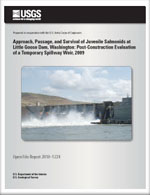This report describes a study of dam passage and survival of radio-tagged juvenile salmonids after installation of a temporary spillway weir (TSW) at Little Goose Dam, Washington, in 2009. The purpose of the study was to document fish passage and survival when the dam was operated with the TSW in place. Spillway weirs are one of several methods used to improve downstream passage of juvenile salmonids. Each spillway weir design is based on the concept of providing an overflow weir with a depth more similar to the natural migration depth of juvenile salmonids than conventional spill bays. Little Goose Dam was the last of the four lower Snake River dams to have a spillway weir installed. This was the first year that some form of surface passage device was operating at all Snake River and Columbia River dams between Lewiston, Idaho, and the Columbia River estuary.
The study design stipulated that a total of 30 percent of the river discharge would continuously be passed over the TSW and the conventional spill bays, and this percentage was achieved. The TSW also was to be operated at the ?low crest? elevation during the spring and the ?high crest? elevation during the summer, but the TSW was only operated at the low crest elevation during this study.
Behavior, passage, and survival of spring and summer juvenile salmonid migrants passing through Little Goose Dam were examined using radio telemetry. Survival was estimated using the Route Specific Survival Model (RSSM) by releasing tagged fish near Central Ferry State Park 21 kilometers upstream of the dam and in the tailrace approximately 0.5 kilometer downstream of the dam. From April 18 to May 21, 2009, 1,520 yearling Chinook salmon (Oncorhynchus tshawytscha) and 1,517 juvenile steelhead (O. mykiss) were radio tagged and released. From June 6 to July 5, 2009, 4,251 subyearling Chinook salmon (O. tshawytscha) were radio tagged and released. Release dates of subyearling Chinook salmon were selected to avoid ?reservoir-type? fish that cease to migrate around July. Detection sites were installed in the forebay 2 kilometers upstream of the dam, on the dam, and at several sites downstream. Detection equipment was operated from April 18 to June 5, 2009, and from June 6 to July 6, 2009, hereinafter referred to as the study periods. We describe passage behaviors through the forebay, main passage routes, and tailrace, survival probabilities through the pool (release to the forebay) and forebay and passage and survival probabilities through the main passage routes (TSW, conventional spill bays, turbines, juvenile bypass), and survival passing the concrete (the dam itself) and the dam (concrete plus the forebay).


